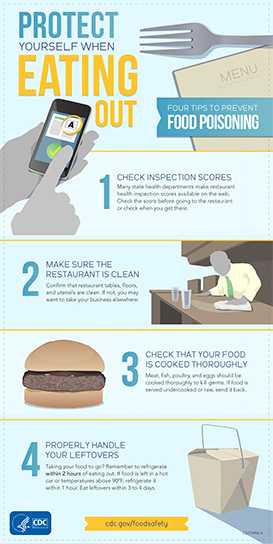14 Tips for a Healthy Valentine's Dinner
 Don’t let your heart cloud your judgment about safe and healthy food choices.
Don’t let your heart cloud your judgment about safe and healthy food choices.
When it comes to Valentine’s Day you’ve got choices: flowers or chocolate; dine in, dine out; gourmet cuisine or home cooking. Whatever you choose, make sure you celebrate love with a safe and heart-healthy meal.
Americans dine out—a lot.
Consider this: each year, consumers spend about half of every food dollar dining out1 while 65% of foodborne outbreaks involved food prepared in a restaurant. These numbers aren’t meant to alarm you, but to encourage safe and healthy choices.
Table for Two
Follow these seven simple steps to keep your valentine safe and healthy while eating out.
- Assess the scene. Look for certificates that show food-safety practices (for example, most recent health inspection score and manager’s completion of food-safety training). Note whether the glasses, silverware, napkins and tablecloths are clean.
- Beware of unlikely sources of sodium. More than 40% of sodium that we eat comes from these common foods: bread and rolls, cold cuts and cured meats, pizza, poultry, soups, sandwiches, cheese, pasta dishes, meat dishes, and snacks.
- Know the facts. Look up the nutritional information in advance. Most major restaurant chains have this data online.
- Order it cooked thoroughly. Remember that foods like meat, poultry, and fish need to be cooked to a temperature high enough to kill harmful bacteria that may be present.
- Ask before ordering. Raw or undercooked eggs can be a hidden hazard in foods like Caesar salad, custards, and some sauces, unless they are commercially pasteurized. Also, most restaurants offer lower sodium options for entrees and dressings, so check the menu or ask the staff for suggestions.
- Sharing is caring. If you do dine out, consider ordering one entrée to share. Many restaurant servings are enough for two.
- Get that doggie bag in the fridge—fast. If you’re not going straight home (within two hours of being served or one hour if temperatures are above 90°F), leave the leftovers at the restaurant.
Take It To Heart
This Valentine’s Day make the choice to lead a heart-healthy lifestyle.
- Heart disease causes one in four deaths in the United States
- 90% of Americans (2 years and older) consume too much sodium
- More than 75% of sodium that Americans eat comes from processed and restaurant food—not the salt shaker

Million Hearts® is a national initiative that has the goal of preventing 1 million heart attacks and strokes by 2017.
A Quiet Night In
Remember these seven tips for takeout, delivery, or preparing your sweetheart’s favorite home-cooked meal.
- Choose low-sodium options. Spice up your meal with seasonings and avoid prepackaged mixes that may contain a lot of salt (or look for low-sodium or salt-free versions).
- Make recipes healthier. Look for healthy substitutions for saturated fats, trans fats and cholesterol in your favorite baked goodies.
- Steer clear of frying. Opt for cooking methods that add little or no fat, like roasting, grilling, or steaming.
- Keep HOT Food HOT! Once food is cooked it should be held at an internal temperature of 140°F or above. Just keeping food warm (between 40°F and 140°F) encourages fast growth of germs that cause foodborne illness, also known as food poisoning. Use a food thermometer to make sure your meal stays out of the danger zone.
- Keep COLD Food COLD! Cold foods should be kept at 40°F or below.
- Follow the two-hour rule. Throw away all perishable foods such as meat, poultry, eggs, and casseroles that have been left at room temperature longer than two hours (one hour in temperatures above 90°F).
- Continue the celebration. If your romantic dinner is just too big to finish, go ahead and put it in the fridge or freezer—but eat it within three to four days.
References
More Information
- Page last reviewed: February 10, 2017
- Page last updated: February 10, 2017
- Content source:
- National Center for Emerging and Zoonotic Infectious Diseases
- Page maintained by: Office of the Associate Director for Communication, Digital Media Branch, Division of Public Affairs




 ShareCompartir
ShareCompartir
